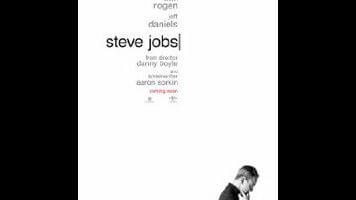The tension between Aaron Sorkin and Danny Boyle drives Steve Jobs

It’s a scene straight from the Aaron Sorkin playbook: A prickly, smartass genius man explains to a naïve female subordinate how coincidences work—and specifically, how a coincidence is responsible for the genius’ computer project sharing her name. Only in this case, the man performing the calmly rational condescension is Apple co-founder Steve Jobs (Michael Fassbender), and the female subordinate is his 5-year-old daughter, who he refuses to acknowledge as such. Though even the child has touches of Sorkin in her voice, this is not banter. It’s chilly at best, and cruelty at worst.
Funny thing about Sorkin, Oscar-winning screenwriter and creator of beloved TV shows plus The Newsroom: When he’s forced to remove the prospect of romance from his prickly genius chronicles, his self-awareness seems to shoot way up. In Steve Jobs, as in his award-winning work for The Social Network, the lack of a quasi-screwball rom-com framework frees the characters from Sorkin’s notions of what constitutes endearing behavior, and the supercharged one-upmanship of his dialogue fuels relationships with real give and take.
Of course, Social Network and Steve Jobs are also both about real-life technology pioneers; it’s possible that Sorkin simply couldn’t ever lionize a real Great Man as much as the ones he creates for his TV shows. It’s also possible that despite his past small-screen successes, he works best as a screenwriter, collaborating with directors who can tame his stubborn, sometimes frustrating talent. Here that task falls to director Danny Boyle, and his approach to the material is one of the major distinctions between this film and David Fincher’s take on The Social Network. Sorkin, reaching back to his playwright roots, devises a theatrical structure for his non-biography that doesn’t seem immediately suited to Boyle’s kinetic talents. He dedicates the film’s two hours to, essentially, three extended sequences, each set in the moments just before a major Jobs-driven product launch. In 1984, Jobs prepares to show off the Macintosh teased in the famous Super Bowl spot from earlier that year; in 1988, he’s off on his own, prepping the NeXT educational computer; and in 1998, he’s back at Apple, about to unveil the iMac (and, in a slightly cheesy touch, dropping a hint about the iPod to come). All three segments unfold in something like real time, and feature recurring figures: Apple co-founder Steve Wozniak (Seth Rogen), past Apple CEO John Sculley (Jeff Daniels), marketing guru Joanna Hoffman (Kate Winslet), and that pesky daughter Lisa (at 5, 9, and 19).
Little of the presentations themselves are shown; really, this is another round of Sorkin backstage choreography (though Jobs only comes across as marginally more self-important and megalomaniacal than the cast and crew of Studio 60 On The Sunset Strip). It seems a bit confining for Boyle, who may have made a movie about a guy trapped under a rock but certainly didn’t limit his camera to that physical environment. He doesn’t here, either; each segment includes a brief cut-up flashback to an earlier episode in Jobs’ life, adding a touch of Boyle montage to the Sorkin walk-and-talk rhythms. But even allowing himself to occasionally cut out of the limited timeframe, Boyle does work in a more disciplined mode than usual. He uses a different format for each of the segments: the warm graininess of 16mm film for the scrappiness of Apple circa 1984; crisper 35mm film for the corporate drama of 1988; and whiter, more washed-out digital for the harsher lessons Jobs learns in 1998. Though the differences are clear, the technique doesn’t register as a gimmick; Boyle, usually an exuberant showman, doesn’t call a lot of attention to his style here. Some of the flashiest filmmaking happens during the transitions, as when the camera follows Lisa through the bowels of Carnegie Hall as the 1988 segment begins, Bob Dylan playing on the soundtrack. (Another sign of Boyle’s discipline: His usually eclectic soundtrack cuts are mostly Dylan this time around.)
The tension between Boyle’s restless energy and Sorkin’s tendency to run in place drives the movie. It also reflects their version of Jobs, who spends a lot of time trying to look beyond the immediate problems in front of him, toward his next move—a quality the movie shows as both brilliant and damaging at once. (Sorkin also calls attention to his dramatic devices when he has Jobs remark that “it’s like five minutes before each launch, everyone goes to the bar, gets drunk, and tells me what they really think.”) Fassbender was basically born to play these qualities simultaneously. More surprising is the electricity of his scenes opposite Rogen, as the dorkier, clunkier Wozniak, who is cursed with a stronger sense of empathy and who needles Jobs to acknowledge people besides himself. He also spars well with Winslet, in fine form as Hoffman. Really, all of the actors give weight to Sorkin’s quips.
For all of its snap and crackle, Steve Jobs doesn’t pack quite the same punch as The Social Network or, for that matter, Boyle’s best films. Sometimes Sorkin’s script seems to be imposing the deposition-heavy structure of his Facebook movie onto a story without any actual court proceedings, and while the movie doesn’t worship at the altar of its subject, its jabs don’t always have the sting of true revelation. The latter would be more of a problem if the movie made a serious attempt at definitive biography. What Boyle and Sorkin pull off in its place is smarter and trickier: a portrait of a “closed system” man expressing himself, imperfectly, through consumer electronics.